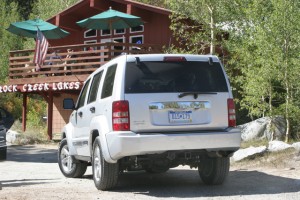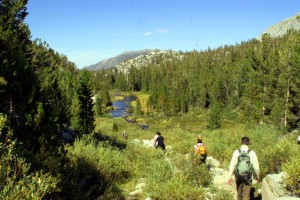Rock Creek California’s Mosquito Flats Trailhead is a quick path to the Eastern Sierra backcountry.
By Rick Shandley, Photography: Dan Sanchez
As summer turns to fall, and fall turns to autumn, the Eastern Sierra Nevada offers an explosion of color from the leaves of deciduous trees nestled amongst stands of evergreen pine. Trees like the quaking aspen, oak and other leaf bearing varieties whose leaves turn from green to infinite shades of gold, yellow, and in rare cases, red. And there’s an almost infinite pallet of year round-backcountry adventures available to hikers, campers, and most any outdoor activity a person could ask for. So we loaded up our 2009 Jeep Liberty 4×4 and headed for Rock Creek Lake, 25 miles northwest of Bishop, CA on U.S. 395.
Bishop is a small town located at the northern end of Owens Valley, on the eastern side of California, and only a short distance from the state of Nevada. Bishop has historically been considered the gateway city of the Sierra Nevada mountain range. It’s large enough to have the stores and services people need, but small enough to where most the action happens on the main drag through town on U.S. 395. There are lots of good places to eat, and stock up on food and fishing tackle, before you make your way to your destination. We went straight to the U.S. Forest Service office to inquire about backcountry permits and to pick up a bear canister. We couldn’t get a backcountry permit, but we headed to our destination in the Rock Creek Recreation Area nonetheless.

As you climb from the valley floor where Bishop lies at 4,147 feet elevation, you ascend Sherwin Grade up to 7,000 feet at the summit where you’ll see the sign to Tom’s Place on the left. Tom’s Place was built in 1917 as a gasoline stop and general store for the early California travelers who were already discovering the beauty and challenges of Sierra’s. This is a place where locals and visitors can have a meal and talk about the fishing in the nearby lakes, streams, and rivers. The current owners have brought back the once popular community potlucks, barbeques, and holiday parties for whoever happens to be around. On Saturday evenings during the summer, they cook up BBQ ribs for $12 a plate. Campers and fishermen flock from Rock Creek and the Crowley Lake area to feast and fellowship just like the old days. The turn off for Tom’s Place is also the approach to the Rock Creek Recreation Area.
Rock Creek Lake is about nine miles up the canyon, and south from the Tom’s Place turnoff. Within five miles you start to enter a glorious sub-alpine environment. This canyon and many of the lakes and trails leading into the backcountry from Rock Creek Lake, and Mosquito Flats trailhead is a great place to evaluate equipment, have a good time, and get into the high country quick. I chose this area because it’s also where I spent entire childhood and teenage summers in this canyon, and know well enough to be confident testing brand new gear. And the terrain is rugged enough to challenge equipment while offering the choice to camp below timberline or above it. The high elevation can also bring in inclement and windy weather real quick; weather that good tents need to hold up to. Furthermore, the thin air becomes a challenge for gear like backpacking stoves and cooking times. And the rock strewn trails will quickly reveal whether hiking or backpacking boots are the real deal or not.

From Rock Creek Lake (elevation 9,600 ft.) you can access the John Muir Wilderness above the trailhead at Mosquito Flats (elevation 10,300 ft.) Within a mile after you hike up trail and meet your first grade, called “Crankcase Hill” you’ll start to see the gems of Little Lake Valley with lake names like Box, Mack, Marsh, Heart, Chicken Foot and others, all with brook, brown, and rainbow trout; some with native golden trout. Backpackers also have the option of vectoring away from Little Lakes Valley to trudge up and over Mono Pass at 12,000 ft. into the deep backcountry, the Pacific Crest Trail, and a myriad of sub-alpine and alpine destinations.
Our primary goal was to start evaluating, photographing, and become familiar with much of the new backpacking gear you’ll be reading about in upcoming product reviews. We found a very cool place just below Rock Creek Lake to set up the new Hilleberg Kaitum 3 and Kelty Foxhole 3, both four-season tents, and go for a hike above Mosquito Flats.

Now we had a good base-camp where we could hike out from and test the gear. From here we were able to cinch-up the fully loaded new 2010 Lowe/Alpine TFX Cerro Torre 65:85 and the Kelty Pawnee 3300 backpacks and get a sense of design characteristics and comfort levels with approximately 40-pounds in each pack. Although we could get the pack-weight down much lighter, we chose the 40-pound range to load-up the packs enough so design and load-bearing qualities would have to be well constructed in order to be comfortable.
Although there were only hints of the fall colors on this trip, we are watching the clock count down until our next run into the Sierra’s where we hope to get a couple more trips in before winter comes. And it won’t be long before the nights start to get cooler, then flat cold, and the weather change will cause the leaves to literally paint the canyons and mountainsides, before they fall off completely until spring. There’s still plenty of time to get yourself and your family up to Bishop, Mammoth Lakes, or any of the wonderful little destination spots to view this change of colors and climate along the Eastern High Sierra.
About Back Country Permits and Bear Canisters in the Sierra Nevada Mountains:
In the Sierra Nevada mountain range, as many of you may be aware, the U.S. Forest Service requires you to use a bear-proof container to store your food when backpacking. You also need to acquire a backcountry permit which is best described as a contract between you and the Forest Service about your conduct and level of preparedness in the forest. So you’ll need to do a little planning as you figure out the logistics of your trip. You’ll also need to save some room in your backpack for that blasted bear canister! Bear in mind, that you can rent the canister’s for five-bucks for the duration of your stay. But also be aware that you’ll have to put down an $82.00 deposit on your credit card incase you forget to return the mini-beer-keg-size item to the Forest Service office you picked it up from. The Forest Service does have a more proactive method for securing backcountry permits by using a form you can request to fax in your reservation dates. But the bear canister is a must; so buy it or plan to rent it, but don’t get caught without it. Rangers will kindly address you on the trail and ask for your permit and pony keg.
Check out the gear list below for the items we will be doing product reviews on in the coming weeks.
New Product Gear List:
- Hilleberg Kaitum 3 four-season mountaineering tent
- Kelty Fox-Hole 3 four-season mountaineering tent
- Mountain Khakis Original Mountain Pants with fleece lining – new for Fall 2009
- Primus ETAPackLite stove and cooking kit
- MSR Reactor stove
- MSR Quick 2 System – cooking kit for two designed for the Reactor stove
- Lowe/Alpine 2010 Cerro Torre 65:85 top-loader backpack
- Kelty Pawnee 3300 backpack (new for 2010)
- Sierra Designs Arrow Rock 45 Flex down sleeping bag
- Therm-A-Rest NeoAir sleeping pad
- Lowa Mt. Expert GT mountaineering/backpacking boots
- Wolverine Fortis hiking boots
- Wenger Eiger hiking boots
- 5/10 Exum hiking boots
- Benchmade Marc A. Lee sheath knife
- Origo Rendezvous Peak watch (Compass, Altimeter, Barometer, Data Tracking, etc.)
- Eco-Usable Stainless Steel water bottles ( 1-liter, ½-Liter)
- Eco-Usable Stainless Steel water bottle with filter
- SIGG Stainless Steel water bottles
- TyRi-dehydrated foods (Alpine Aire, Natural High, Richmoor)

That looks like a beautiful area. I have always wanted to camp outside the Bishop area. I have travelled through it a few times on my way to ski Mamoth. Thanks for giving me the bug to go up there to camp and fish again!